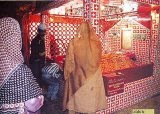Entrance to the Villa of Mysteries, Pompeii, Rome (Destroyed in 79 CE)
On 24th of August, 79 CE, Mount Visuvious erupted in the dead of the night when the people in the Roman cities of Pompeii and Herculanaeum slept. Both of these fine cities of the Roman Empire were destroyed by the volcanic lava, their citizens and their residences along with all their belongings encrusted in the molten lava. Herculanaeam was rediscovered in 1738 and Pompeii in 1748. (See here). Their buildings went through a series of destructions before the archaeological conservation began. Yet, almost entire villas were found preserved below the volcanic debris, alongwith the bodies of people who were not able to escape their fate.
Villa of Mysteries, Restored Exterior (See Original Image Here)
Villa of Mysteries Inner Courtyard (See Original Image Here)
One such villa which has been found intact is called the Villa of Mysteries, lying in the suburbs outside Pompeii. The identity of the owner of this villa is not established. But this building is particularly interesting because of the series of narrative wall paintings around the inner wall of one the chambers inside the villa. The theme of the narrative has not been definitely identified and hence, it is called the Villa of Mysteries.
Villa of Mysteries an Artist's Reconstruction (See Original Image Here)
Villa of Mysteries Plan and Reconstruction (See Original Image Here)
This villa had a vineyard and farms annexed to it. The building housed a large wine-press and wine-cellar. This, combined with the fact that it lies outside the urban centre of Pompeii, the wall paintings lend themselves to a possible interpretation of being related to some kind of secret Bacchanalian ritual. The inner chamber possibly served as a place for this secret ceremony.
In ancient Greece, there was a cult of god Dionysus, who was associated with vineyards and wine-making and drinking. His public ceremony involved much drinking and feasting, using intoxicants and trance-dancing with music and song. It has been postulated that this cult was older than the Classical Olympian cults and may have travelled either from Asia Minor or from North Africa, spread into Minoan Crete and from there to the ancient Greek regions. Its earliest practice may have been as old as about 6000 BCE and it may have entered Crete (3000 to 1000 BCE) about 1500 BCE or even earlier. It was not a common cult and its followers were restricted to membership by initiation rites. Because of this exclusivity, not much is known about its secret ceremonies. It was transported into the Roman Empire, around 200 BCE, where Dionysus was known as Dionysus Liber or Bacchus. Liber was a Roman fertility god and Dionysus got associated with him (See more on this here).
It has been suggested that the initiation rites for men involved their enacting the persona of Dionysus through life, death and rebirth. This involved a descent into hell in a cavern or catacomb and undergoing some kind of ordeals. A woman initiate enacted as a bride for Dionysus and had to undergo a union with him in the "underworld." The symbol of Dionysus in these rites was a goat's penis or a phallus made of fig-wood. Flagellation and symblic hanging also could be used for women. These rites went on in a secret place while feasting revelries in the honour of Dionysus went on in public. With time, at least in some cases, these rites became painful and involved physical and psychological hardship for the initiates, though it becoming a regular feature of the cult is doubtful. Besides, the mainstream Greco-Roman religion may have faced a threat from this cult. Hence, in time the Roman State banned the cult of Dionysus in 186 BCE for alleged sexual abuse and other atrocities. However, it continued to be practised in secret till about 4th-5th centuries CE, when Christianity became forceful under political patronage (See more here).
Since this villa is located outside the city and has this inner chamber and also served as a large-scale producer of wine, it's quite possible that it was the site for some sort of Dionysian ritual. An alternative interpretation could be that this chamber was the place for feasts and drinking revelries of the Roman aristocrats who were invited by the owner. Hence, a narrative of Bacchanalian ritual was an appropriate decoration for this chamber. A third explanation could be that this depicts a narrative from the Dionysian mythology which has got lost to us from history.
Wall Paintings in the Inner Chamber of the Villa of Mysteries (See Original Image Here)
As noted earlier, the identification of these paintings is debated. But a suggested identification following the Dionysian initiation rites follows the sequence of figures as - a matronly woman (the girl initiate's mother?) stands in an authoritative fashion, a young boy reads a scroll (ceremonial verses?) a female attendant brings some cake-like objects on a platter (offerings for Dionysus?), a priestess (?) performs purification for some myrtle leaves (?) held by a female attendant in a tray, aged Silenus playing music for Dionysus, a nymph suckling a goat and the girl initiate standing nearby.
Detail from above (See Original)
Detail from Above (See Original)
Wall paintings in the Villa of Mysteries (See Original)
The next sequence of paintings have been suggested to portray Silenus offering a wine bowl to a Satyr, a Satyr holding a mask and a second one seeing his reflection in the bowl. Wearing masks during Bacchanalian dances was a common practice. This scene may also symbolise taking off the mask that we wear and looking at our true selves as a form of liberating experience during drunken revelry that was a part of these feasts. Next to this is Dionysus, who is the only figure definitely agreed upon by the scholars. He is spreading himself in the lap of either his mother Semele or Ariadne, his wife. Next is the girl initiate before the symbol of Dionysus i.e., a fig-wood phallus called herm.
Continuation of the Scene Above (See Original)
This scene continues from the previous one described above. In this we find that the girl is leaning before the herm, a priestess (?) stands with a staff in hand and a winged creature raises a whip to lash the girl (?).
Wall painting in the Villa of Mysteries (See Original)
In this scene which follows on the next wall, the girl is being comforted by another priestess (?) and a woman stands sounding cymbals while another woman holds a staff over the seated priestess (?). Perhaps this symbolises that the initiation rite is completed. The symbolic union of the girl with Dionysus is not shown here, though Dionysus himself presides over the ceremony.
Final Scene, Villa of Mysteries (See Original)
In the final scene, a woman (the girl initiate?) is dressed up and her hair is being combed by another woman. Perhaps she is dressing up now after the ceremony to join in the Bacchanalian feast (?). Or perhaps she is someone else (?).
There is another way of looking at these paintings. Rather than seeing them as inter-connected, they can also be seen as separate scenes related to the Dionysian cult. It's possible that this room was used for some kind of ceremony for sanctifying freshly-harvested grapes and newly-pressed wine, in which a feast of Dionysus and some rites for him were held. Hence, most activities related to the Dionysin cult such as food offering, feeding goats for sacrifice, wearing of masks for dance, initiation rites, music on cymbals and a woman dressing to join the revelry are depicted on the wall of this room, while Dionysus himself presides over all these activities. The "Initiation rites" may also be perceived as exorcism rites which may have been practised by the Dionysians, since flogging is involved.
There is another way of looking at these paintings. Rather than seeing them as inter-connected, they can also be seen as separate scenes related to the Dionysian cult. It's possible that this room was used for some kind of ceremony for sanctifying freshly-harvested grapes and newly-pressed wine, in which a feast of Dionysus and some rites for him were held. Hence, most activities related to the Dionysin cult such as food offering, feeding goats for sacrifice, wearing of masks for dance, initiation rites, music on cymbals and a woman dressing to join the revelry are depicted on the wall of this room, while Dionysus himself presides over all these activities. The "Initiation rites" may also be perceived as exorcism rites which may have been practised by the Dionysians, since flogging is involved.
Till the paintings are definitely identified, we will not know what narrative is shown here. At best the above description is an educated guess of the scholars. But these paintings and the villa, dating to pre-79 CE, show the advanced state of art and architecture of Pompeii. It also shows the social and cultural life of that era.



























































